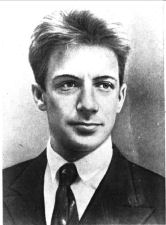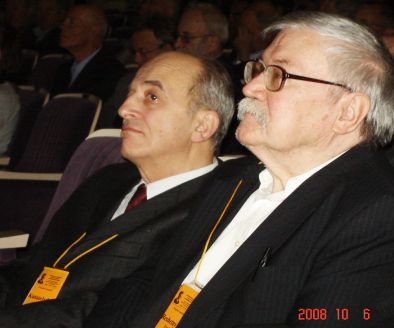

Sergei Sobolev belongs to the Russian mathematical school and ranks among the scientists whose creativity has produced the major treasures of the world culture.
Mathematics studies the forms of reasoning. Generally speaking, differentiation discovers trends, and integration forecasts the future from trends. Mankind of the present day cannot be imagined without integration and differentiation. The differential and integral calculus was invented by Newton and Leibniz. The fluxions of Newton and the monads of Leibniz made these giants the forerunners of the classical analysis. Euler used the concepts by Newton and Leibniz to upbring and cultivate the new mathematics of variable quantities, while making quite a few phenomenal discoveries and creating his own inexhaustible collection of miraculous formulas and theorems. Mathematical analysis remained the calculus of Newton, Leibniz, and Euler for about two hundred years. The classical calculus turned into the theory of distributions in the twentieth century. As the key objects of the modern analysis are ranked the integral in the sense of Lebesgue and the derivative in the sense of Sobolev which apply to the most general instances of interdependence that lie beyond the domains under the jurisdiction of the classical differentiation and integration. Lebesgue and Sobolev entered into history, suggesting the new approaches to the integral and derivative which expanded the sphere of influence and the scope of application of mathematics.
The historic figures and discoveries deserve the historical parallels and analysis. The gift of mathematics translates from teacher to student. The endless chain of alternating generations incarnates a mathematical tradition. Characterizing a scientific school, Luzin observed that “the elder school is more precious. Indeed, any school is the collections of the creative techniques, traditions, and narrations about the past and still living scientists as well as their manners of research and views of the object of research. These narrations are collected for ages but not intended for publication or revelation to those that seem undeserving. These narrations are treasures whose power is impossible to imagine oroverrate.... If some analogy or comparison is welcome then the age of a school, together with the stock of its traditions and narrations, is nothing else but the energy of the school in implicit form.” Sobolev belongs to the school that originated with Leonhard Euler (1707–1783).
Man is a physical object and as such can be partly represented by his worldline in the 4-dimensional Minkowski space-time. “Mathematics knows no races or geographic boundaries; for mathematics, the cultural world is one country, ”' Hilbert said at the Congress in Bologna in 1928. No state is a physical object. In space-time we may identify a country with the funnel of the worldlines of its inhabitants. The longest part of the worldline of Euler belongs to Russia. There is neither Russian nor Swiss mathematics. However, there is mathematics in Russia, there is a national mathematical tradition, and there is a national mathematical school. Born in Switzerland, Euler found his second homeland in Russia and is buried in the soil of St. Petersburg. Da Vinci of mathematics, he had become part and parcel of the Russian spirit. Our compatriots are proud to acknowledge Euler as the founder of the Russian mathematical school.
The efforts of Euler made Petersburg the mathematical capital of the eighteenth century. Daniel Bernoulli wrote to Euler: “I fail to convey to you quite properly how greedily they ask everywhere for the Petersburg memoirs.” Implied were the celebrated Commentarii Academiae Scientiarum Imperialis Petropolitanae which became a leading scientific periodical of that epoch. The title of the journal changed many times and reads now as Proceedings of the Russian Academy of Sciences (Mathematical Series). The journal of the Petersburg Academy of Sciences published 473 Euler's articles which were printed successively during many years after his death up to 1830.
At the turn of the nineteenth century the center of mathematical thought shifted to France, the residence of Laplace, Poisson, Fourier, and Cauchy. The ideas of the new creators of mathematics were perceived by Ostrogradskii who studied in Paris after he was deprived of his legitimate Graduation Diploma of Kharkov Imperial University. Cauchy appraised Ostrogradskii in one of his papers of 1825 as a youngster gifted with a keen vision and rather knowledgable in infinitesimal calculus. The reputation of Ostrogradskii in France, as well as a few memoirs submitted to the Academy of Sciences, led to the recognition of his merits in Russia. It was already in 1832 when Ostrogradskii was elected as an ordinary academician in applied mathematics at the age of 32. Soon he became an undisputed leader of the Russian mathematical school.
Ostrogradskii was fully aware of the importance of Euler to the science in Russia. He vigorously raised the question of publishing the legacy of Euler. In a relevant memo, Ostrogradskii wrote: “Euler created the modern analysis, enriching it more than all his predecessors and making it the most powerful tool of human mind.” The collection of 28 volumes was to be completed in 10 years, but the Academy had found to finances neither then nor by now....
N. D. Brashman, N. E. Zhukovskii, and S. A. Chaplygin are usually listed in the Moscow branch of the school of Ostrogradskii. The Petersburg branch included P. L. Chebyshev, A. M. Lyapunov, V. A. Steklov, and A. N. Krylov. Many other Russian mathematicians and mechanists were influenced by the research, teaching, and personality of Ostrogradskii.
Among the students of Chebyshev we list A. N. Korkin and A. A. Markov who taught N. M. Günter, the future supervisor of the graduation thesis of Sobolev. As his second teacher, Sobolev acclaimed V. I. Smirnov, a student of V. A. Steklov who himself was supervised by A. M. Lyapunov. So is the brilliant chain of the scientific genealogy of Sobolev.
Euler's archive belongs to Russia. However, the publication of the collected works of Euler was accomplished in Switzerland with the active participation of A. M. Lyapunov, A. N. Krylov, A. A. Markov, and V. I. Smirnov. The best minds of Russia strove to save the intellectual legacy of Euler. Smirnov rephrased the words of Goethe about Mozart as follows: “Euler will always remain a miracle beyond our ability to explain.”
Sobolev's contributions are connected with the reconsideration of the concept of solution to a differential equation. He suggested that the Cauchy problem be solved in the dual space, the space of functionals, which means the rejection of the classical view that any solution of any differential equation presents a function. Sobolev proposed to assume that a differential equation is solved provided that all integral characteristics are available of the behavior of the process under study. Moreover, the solution as a function of time may fail to exist at all rather than be unknown for us temporarily. In actuality, science has acquired a new understanding of the key principles of prognosis.
It was as long ago as in 1755 that Euler gave the universal definition of function which was perceived as the most general and perfect. In his celebrated course in differential calculus, Euler wrote: “If, however, some quantities depend on others in such a way that if the latter are changed the former undergo changes themselves then the former quantities are called functions of the latter quantities. This is a very comprehensive notion and comprises in itself all the modes through which one quantity can be determined by others. If, therefore, x denotes a variable quantity then all the quantities which depend on x in any manner whatever or are determined by it are called its functions.”
The generalized derivatives in the Sobolev sense do not obey the Eulerian definition of function. Differentiation by Sobolev implies the new conception of interrelation between mathematical quantities. A generalized function is determined implicitly from the integral characteristics of its action on each representative of some class of test functions that was chosen in advance.
The discoveries by Newton and Leibniz summarized the centenary-old prehistory of differential and integral calculus, opening the new areas of research. The achievements of Lebesgue and Sobolev continued the contemplations of their glorious predecessors and paved the turnpike for the present-day mathematicians. Sobolev was among the pioneers of application of functional analysis in mathematical physics, propounding his theory in 1935. In the articles by Laurent Schwartz who came to the similar ideas a decade later, the new calculus became comprehensible and accessible for everyone in the elegant, powerful and rather transparent form of the theory of distributions which has utilized many progressive ideas of algebra, geometry, and topology.
The differential calculus of the seventeenth century is inseparable from the general views of the classical mechanics. Distribution theory is tied with the mechanics of quanta. We must emphasize that quantum mechanics is not a plain generalization of the mechanics of classics. Quantum mechanics presents the scientific outlook that bases on the new laws of thought. The classical determinism and continuity swapped placed with quantization and uncertainty. It was in the twentieth century that mankind raised to a completely new comprehension of the processes of nature.
Similar is the situation with the modern mathematical theories. The logic of these days is not a generalization of the logic of Aristotle. Banach space geometry is not an abstraction of the Euclidean plane geometry. Distribution theory, reigning as the calculus of today, has drastically changed the whole technology of the mathematical description of physical processes by means of differential equations.
Sobolev heard the call of the future and bequeathed his spaces to mankind. His discoveries triggered many revolutionary changes in mathematics whose progress we are happy to observe and follow. The terminal series of Sobolev's mathematical articles was devoted to the subtle properties of the roots of the Euler polynomials....
January 8, 2008

| English Page |
Russian Page |